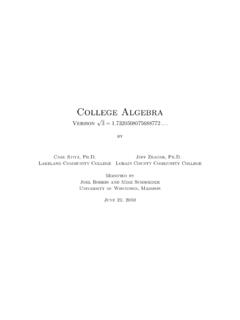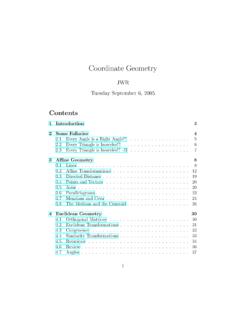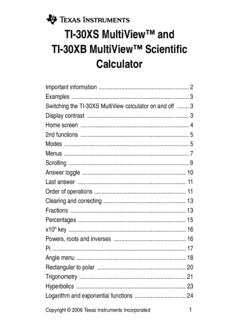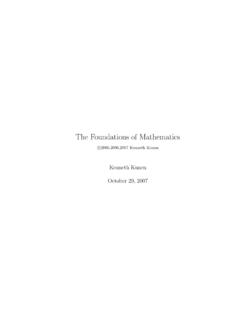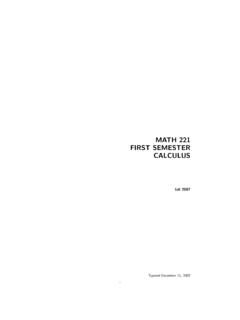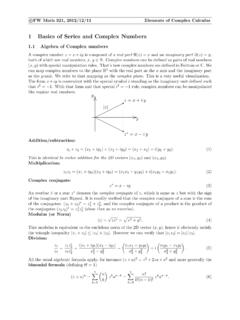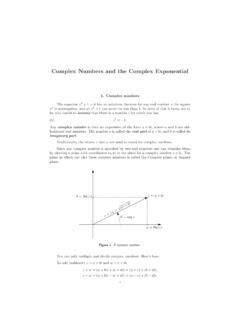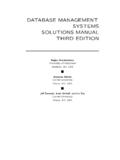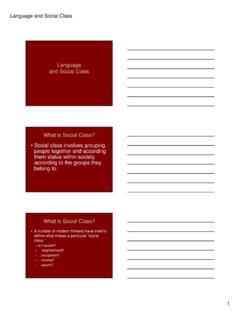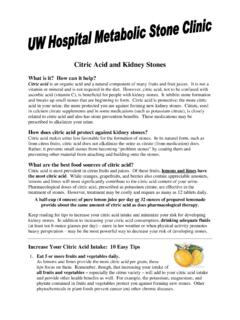Transcription of MATH 221 FIRST SEMESTER CALCULUS - University of …
1 MATH 221 FIRST SEMESTERCALCULUS fall 2009 Typeset:June 8, 20101 MATH 221 1st SEMESTER CALCULUSLECTURE NOTES VERSION (fall 2009)This is a self contained set of lecture notes for Math 221. The notes were written by Sigurd Angenent, startingfrom an extensive collection of notes and problems compiled by Joel Robbin. The LATEX andPythonfileswhich were used to produce these notes are available at the following web ~angenent/Free-Lecture-NotesThey are meant to be freely available in the sense that free software is free. More precisely:Copyright (c) 2006 Sigurd B. Angenent. Permission is granted to copy, distribute and/ormodify this document under the terms of the GNU Free Documentation License, or any later version published by the Free Software Foundation; with no InvariantSections, no Front-Cover Texts, and no Back-Cover Texts.
2 A copy of the license isincluded in the section entitled GNU Free Documentation License .ContentsChapter and is a number? functions and Implicit (1) tangent to a example tangent to a of of rates of and Continuous definition of formal, authoritative, definition of on the limit of the of limit limits fail to s in a name? and in Limits in (2) computation of implies non-differentiable Differentiation powers of Trigonometric Chain Sketching and Max-Min and Normal lines to a Intermediate Value sign changes of a and decreasing and there always be a maximum? functions with and without maxima method for sketching the graph of , Concavity and the Second Derivative of some of the and Logarithms (naturally) of of exponential functions and derivative ofaxand the definition of involving exponentials and growth and under a its Fundamental Theorem of indefinite of the definite integral as a function of its of of the between s principle and volumes of of volumes of solids of by cylindrical from velocity, velocity from acceleration length of a of length done by a done by an electric current119 Chapter and Hints121 GNU Free Documentation License12531.
3 APPLICABILITY AND DEFINITIONS1252. VERBATIM COPYING1253. COPYING IN QUANTITY1254. MODIFICATIONS1255. COMBINING DOCUMENTS1266. COLLECTIONS OF DOCUMENTS1267. AGGREGATION WITH INDEPENDENT WORKS 1268. TRANSLATION1269. TERMINATION12610. FUTURE REVISIONS OF THIS LICENSE12611. RELICENSING1264 CHAPTER 1 Numbers and FunctionsThe subject of this course is functions of one real variable so we begin by wondering what a real number really is, and then, in the next section, what a function What is a number? Different kinds of simplest numbers are thepositive integers1,2,3,4, the numberzero0,and thenegative integers , 4, 3, 2, these form the integers or whole numbers. Next, there are the numbers you get by dividing one whole number by another (nonzero) whole are the so called fractions orrational numberssuch as12,13,23,14,24,34,43, or 12, 13, 23, 14, 24, 34, 43, By definition, any whole number is a rational number (in particular zero is a rational number.)
4 You can add, subtract, multiply and divide any pair of rational numbers and the result will again be arational number (provided you don t try to divide by zero).One day in middle school you were told that there are other numbers besides the rational numbers, andthe FIRST example of such a number is the square root of two. It has been known ever since the time of thegreeks that no rational number exists whose square is exactly 2, you can t find a fractionmnsuch that(mn)2= 2, < > , if you computex2for some values ofxbetween 1 and 2, and check if youget more or less than 2, then it looks like there should be some numberxbetween whose square is exactly 2. So, weassumethat there is such a number, and we call itthe square root of 2, written as 2.
5 This raises several questions. How do we know therereally is a number between and for whichx2= 2? How many other such numbersare we going to assume into existence? Do these new numbers obey the same algebra rules(likea+b=b+a) as the rational numbers? If we knew precisely what these numbers (like 2) were then we could perhaps answer such questions. It turns out to be rather difficult to give a precisedescription of what a number is, and in this course we won t try to get anywhere near the bottom of thisissue. Instead we will think of numbers as infinite decimal expansions as can represent certain fractions as decimal fractions, all fractions can be represented as decimal fractions. For instance, expanding13into a decimal fractionleads to an unending decimal fraction13= 333 333 333 333 It is impossible to write the complete decimal expansion of13because it contains infinitely many we can describe the expansion: each digit is a three.
6 An electronic calculator, which always representsnumbers asfinitedecimal numbers, can never hold the fraction can be written as a decimal fraction which may or may not be finite. If the decimalexpansion doesn t end, then it must repeat. For instance,17= 142857 142857 , any infinite repeating decimal expansion represents a rational numberis specified by a possibly unending decimal expansion. For instance, 2 = 213 562 373 095 048 801 688 724 209 698 078 569 671 875 376 course you can never writeallthe digits in the decimal expansion, so you only write the FIRST few digitsand hide the others behind dots. To give a precise description of a real number (such as 2) you have toexplain how you couldin principlecompute as many digits in the expansion as you would like.
7 During thenext three semesters of CALCULUS we will not go into the details of how this should be A reason to believe in Pythagorean theorem says that the hy-potenuse of a right triangle with sides 1 and 1 must be a line segment of length 2. Inmiddle or high school you learned something similar to the following geometric constructionof a line segment whose length is 2. Take a square with side of length 1, and constructa new square one of whose sides is the diagonal of the FIRST square. The figure you getconsists of 5 triangles of equal area and by counting triangles you see that the largersquare has exactly twice the area of the smaller square. Therefore the diagonal of the smaller square, beingthe side of the larger square, is 2 as long as the side of the smaller are real numbers called real?
8 All the numbers we will use in this FIRST SEMESTER of CALCULUS are real numbers. At some point (in 2nd SEMESTER CALCULUS ) it becomes useful to assume that there is a numberwhose square is 1. No real number has this property since the square of any real number is positive, soit was decided to call this new imagined number imaginary and to refer to the numbers we already have(rationals, 2-like things) as real. The real number line and is customary to visualize the real numbers as pointson a straight line. We imagine a line, and choose one point on this line, which we call theorigin. We alsodecide which direction we call left and hence which we call right. Some draw the number line verticallyand use the words up and down.
9 To plot any real numberxone marks off a distancexfrom the origin, to the right (up) ifx >0, to theleft (down) ifx < along the number linebetween two numbersxandyis|x y|. In particular, thedistance is never a negative number. 3 2 10123 Figure draw the half open interval[ 1,2)use a filled dot to mark the endpoint which is includedand an open dot for an excluded 2 1012 2 Figure find 2on the real line you draw a square of sides1and drop the diagonal onto the real every equation involving variablesx,y, etc. we write down in this course will be true for somevalues ofxbut not for others. In modern abstract mathematics a collection of real numbers (or any otherkind of mathematical objects) is called aset.]
10 Below are some examples of sets of real numbers. We will usethe notation from these examples throughout this collection of all real numbers between two given real numbers form an interval. The followingnotation is used (a,b) is the set of all real numbersxwhich satisfya < x < b. [a,b) is the set of all real numbersxwhich satisfya x < b. (a,b] is the set of all real numbersxwhich satisfya < x b. [a,b] is the set of all real numbersxwhich satisfya x the endpoint is not included then it may be or . ( ,2] is the interval of all real numbers(both positive and negative) which are Set common way of describing a set is to say it is the collection of all real numberswhich satisfy a certain condition. One uses this notationA={x|xsatisfies this or that condition}Most of the time we will use upper case letters in a calligraphic font to denote sets.)
